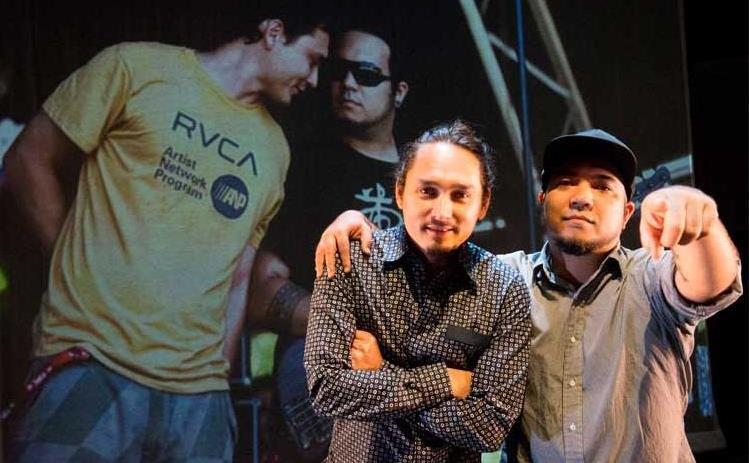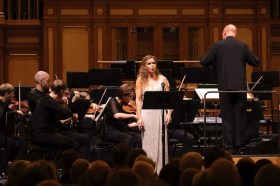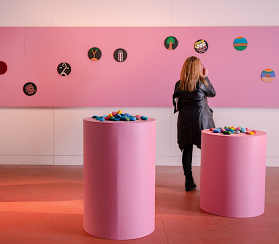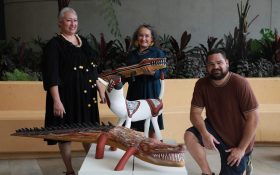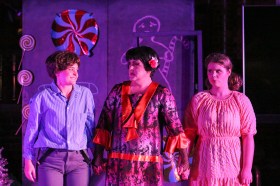Art matters. We know that it makes sense of challenge and difficulty. We know that as a society, we are becoming more isolated and less connected, and that mental health is a massive issue – particularly amongst young people – and that in all of these areas, art has a hugely beneficial impact. We know art creates community, and helps us make meaning, and brings us joy.
Great art shifts the dial for the better – on how we see ourselves and the world.
But back in this room, in the here and now, how’s our mental health? How connected are we feeling? How curious and creative?
Theatre Network NSW’s recent survey reveals we are in a chronic state of anxiety, of stress and fatigue, and of feeling undervalued, and I want to acknowledge just how difficult the current situation is for many artists and arts workers in this room. I hear it and see it every day.
From a neuroscience point of view, we know that long-term stress shrinks our creativity. Is it even possible then, to make great art from this state?
THE CURRENT FUNDING ENVIRONMENT
Let’s look at the current funding environment. What does it look like for independent artists and S2M companies?
If we look at project funding, we know current success rates at a state and federal are less than 20%. Australia Council’s success rate averages at around 15%; the last Create NSW project round was 2.7%.
We also know from 2021 the number of small to medium companies (S2Ms) receiving multi-year funding from the Australia Council will decrease by 25%, meaning there’ll be more competition for reduced project funding at a federal level.
And the new guidelines from Create NSW open up funding to interstate artists and companies, meaning we can expect increased competition for limited project funds at a state level.
‘The current funding environment for independent artists and S2Ms has anxiety and insecurity built-in.’
In terms of project funding for national touring, the current mechanism is challenging – principally because both Australia Council and Create NSW funding are needed for a national tour to go ahead, and there’s currently no decision-making coordination between the two agencies on which tours are successful. It takes up to a year to build a tour and on average 200 to 300 hours of work – liaising and negotiating with dozens of venues, itinerising and budgeting. If only one of the two funding applications is successful, the whole tour falls over.
And there’s another point to be made here that applies to all one-off project funding. If a tour does get up, there’s no avenue for building on its success with a follow up tour and a long-term audience development strategy for that company. Only the National Touring Status initiative facilitates this with multi-year funding, but it’s only available to four companies nationally, and it’s currently under review.
The current funding environment then, for independent artists and S2Ms, has anxiety and insecurity built-in. Funding for making new work is precarious, at best, and it’s difficult to plan for, or capitalise on, success.
This is despite us knowing that the independent and S2M sector is the audience driver and innovation generator of our industry, where the vast majority of new work is made, and where our future takes shape.
The current funding environment then, makes this future precarious.
great art finds success
Let’s shift gear a little, and look back out, at where great art has found success. What conditions have allowed this art to be made, and to find audiences?
One of my favourite stories of 2019 is Dubbo Regional Theatre’s presentation of Cassie Workman’s Giantess – an exquisite one woman show that explores growing up transgender. It’s funny and accessible, heartfelt and clever, and Dubbo venue manager Linda Christof saw an immediate shift in the attitudes of audience members that went on to have a positive ripple effect throughout her community.
Cassie wrote Giantess as an independent artist without project funding. It premiered at Griffin Theatre’s Batch Festival, and was seen by producer Lisa Fresh-water. Lisa and Cassie then pitched it at Arts on Tour’s Salon, where it was seen by Linda Christof – and from there it found its way to Dubbo.
My first thought, is how many Giantess’s are we missing out on, given the scarcity of project funding? How much latent talent does this sector have, that we don’t see?
And secondly, while the gestation of Giantess was precarious, once made, it was lifted and carried by specific initiatives and people in the sector ecology. Batch and Salon provided the showcasing opportunities that enabled it to be seen. They provided connectivity. Lisa Fresh-water provided essential artist support. And Linda Christof provided the cultural leadership and the bravery to take the risk on presenting it.
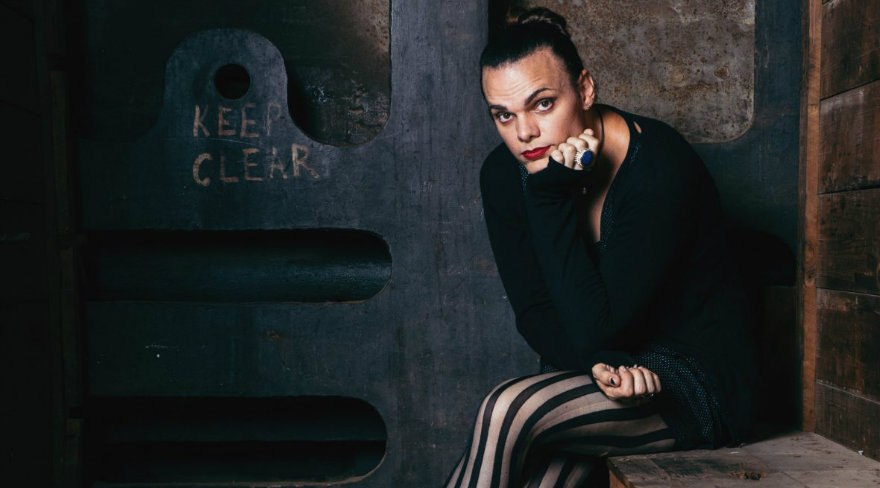
Cassie Workman. Image supplied.
One of our tours this year tells a similar story. In Between Two, from Contemporary Asian Australian Performance, or CAAP for short, was created and performed by James Mangohig and Joel Ma. It toured to 13 venues across Australia and was nominated for tour of the year.
Like Cassie, James and Joel didn’t get project funding to make this work, and like Giantess, In Between Two was lifted and carried to audiences by specific nodes in the ecology: namely the capacity building and artist development support of CAAP, and producer Annette Shun Wah and mentor William Yang. Through CAAP, the work was further developed and found its way to Sydney Festival then Melbourne Festival and OzAsia, before being supported by Arts on Tour to tour nationally.
In Between Two and Giantess survived the gestation process because they were small enough in scale to get their first iteration up without project funding, and this makes them both anomalies. The scarcity of project funding comes at a massive cost to artists and the sector, and our ability to make bold and ambitious new work.
‘The scarcity of project funding comes at a massive cost to artists and the sector, and our ability to make bold and ambitious new work.’
But what I also want to highlight here is the role of the ecology in these works being further developed and finding audiences – where specific organisations provided support, cultural leadership, capacity building and connectivity to carry these fragile pieces of art to audiences far and wide.
Let’s now go to the Bega Valley, to regional arts organisation South East Arts and their inaugural Giiyong Festival – a multi-artform festival celebrating First People’s culture that engaged 6000 people. It took South East Arts three years to bring to fruition and to map a biennial festival framework that will see First Peoples take the lead by 2024.
This Festival is a phenomenal feat for a small arts organisation. Its success, like Giantess and In Between Two, relied primarily on the artistry of the many artists involved, as well as the cultural leadership of South East Arts’ Andrew Gray and team.
But this project also benefited from the stability and security of ongoing operational funding for South East Arts. This enabled the team to leverage its base funding to raise $250,000, including a high proportion of non-arts government and private funding, and partner with local Twofold Aboriginal Corporation. It also gave the project time to develop long-term relationships with local Elders, cultural leaders and artists. And to be bold and ambitious. Without the foundation of stability and security, a project of this vision, scale and impact would not be possible.
Back in Sydney, the success of another work we’re looking to tour, Henrietta Baird’s The Weekend from Moogahlin, was similarly made possible through multi-year funding, this time in the form of a four-year Catalyst project grant for Moogahlin’s Yellamundie playwriting festival, a critical platform for First Peoples’ new writing. Like South East Arts, the security of foundational funding enabled Moogahlin to leverage additional funding and map out long-term outcomes. It gave Henrietta’s work a pathway to be seen, developed and produced by Moogahlin and presented at Sydney Festival – and now reach a broader audience through touring.
These last two stories demonstrate the benefits of multi-year funding, either at an operational or a project level, in providing cultural leaders with the foundation to be financially resourceful and artistically ambitious, and in being able to provide a long-term framework that supports artists to make great work and see it succeed.
CONCLUSIONS
What can we conclude then from these success stories in relation to our current approach to funding?
For me it comes down to three key points.
First and foremost, we need to prioritise empowering and supporting our artists. And this isn’t only about money, but we will get to that. It’s also cultural. As one survey respondent eloquently wrote: ‘the importance of cultivating a culture of respect and encouragement of art and artists cannot be understated’.
Cultivating a more supportive culture, of more transparency from funding agencies, more acknowledgement of how difficult things are, less us and them – would make a big difference.
Secondly, we need to address the inherent insecurity of project funding and acknowledge the real and deep impact this has on the ability of Independent artists and S2Ms – and therefore collectively our ability as a sector – to make new work and great art.
We need a more strategic approach – one that not only funds more creative development for bold new work, but also supports follow up funding and a longer-term view of projects to capitalise on successful new work like In Between Two and Giantess.
But this would require addressing the current critical under investment, and on this major issue TNN supports Theatre Network Australia’s call for an urgent injection of $7M into four-year funding for S2Ms. We also need to urgently and radically reverse the steady decline in project funding investment, essential for the development of new work for both independent artists and S2Ms. At current levels, the best we can do is a scattergun approach, where assessors spread what little there is to as many projects as they can. This does not set us up for success.
And if an increase in funding for the sector is not on the horizon, despite the best efforts of our Arts Minister and funding agencies, and if we want a future of bold and ambitious art, then there seems to be no choice other than a redistribution of current funds, based on artistic quality; return on investment and need; and current and future impact.
And my third and final point is that we need to safeguard the ecology and the existence of specific organisations that play a critical role in determining success – as capacity builders, as catalysts and as connectors. Take one of these away, and the potential for success also falls away.
And that is all I want to say. Except that right now, in this current environment, we need great art – perhaps more than ever. And we owe it to our audiences and our artists to make sure we’re doing everything we can to make great art possible, and to make it matter.
This is an edited version of Antonia Seymour’s keynote speech delivered at Theatre Network NSW’s State of the Sector Address at Belvoir on Wednesday 27 November 2019.
